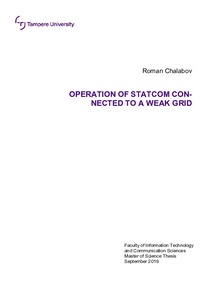Operation of STATCOM connected to a weak grid
Chalabov, Roman (2019)
Chalabov, Roman
2019
Sähkötekniikan DI-ohjelma - Degree Programme in Electrical Engineering
Informaatioteknologian ja viestinnän tiedekunta - Faculty of Information Technology and Communication Sciences
This publication is copyrighted. You may download, display and print it for Your own personal use. Commercial use is prohibited.
Hyväksymispäivämäärä
2019-09-29
Julkaisun pysyvä osoite on
https://urn.fi/URN:NBN:fi:tuni-201909113271
https://urn.fi/URN:NBN:fi:tuni-201909113271
Tiivistelmä
The purpose of this thesis was to investigate the operational possibility of MMC STATCOM in weak grid conditions. Weak grid is a power system which has low short circuit capacity, high equivalent grid impedance, high dV/dQ sensitivity and higher volatility to voltage instability. Hence integration of power electronics based equipment due to their fast response is a big challenge in weak grid. Interaction with high grid impedance of weak grid leads to loss of synchronization and consequently unstable operation of VSC connected to weak grid.
In this thesis first, the effects of high grid impedance on the PLL synchronization was investigated. It was observed that high grid impedance has high impact on PLL dynamics and introduces self-synchronization. However, it was noticed that the PLL remains stable if there is no power exchange between grid and VSC. Therefore, STATCOM performance is not deteriorated by the weak grid conditions. STATCOM model connected to weak grid was simulated in Matlab/Simulink environment to study the impact of the weak grid on STATCOM control system.
Initially STATCOM was simulated as a constant current source to investigate the factors that impacts STATCOM stability. It was found that STATCOM operation in weak and very weak grid conditions is limited due to some factors that affects STATCOM stability. In capacitive mode the amount of the DC link voltage is main limiting factor and insufficient amount of DC link voltage results in the harmonic injection by STATCOM. In inductive mode high reactive power absorption results in high frequency oscillations in grid voltage which leads to loss of synchronization. Making PLL slower improves the synchronization with the grid; however, this modification deteriorates the DC link voltage performance which requires DC link voltage controller retuning.
Second, STATCOM was simulated in the voltage regulation mode and it was noticed that STATCOM operation introduces high frequency ripple to grid voltage. The ripple frequency changes with the grid strengths and at very low short circuit levels system becomes unstable. To improve the system stability a notch filter tuned to the ripple frequency was added. Notch filter significantly improved STATCOM performance and extended the operational limits of STATCOM. However, it was noticed that at some short circuit levels resonance happens and in inductive mode high inductive current absorption makes system unstable. Further elaborations showed that interaction with the HF filter cause the system instability and reduction of the HF filter rating improves the system stability.
Finally, STATCOM performance was tested under symmetrical and asymmetrical fault conditions. In case of asymmetrical fault due to unbalanced grid voltages part of the current is used to balance DC link voltage waveforms and the output current of the STATCOM was reduced.
In this thesis first, the effects of high grid impedance on the PLL synchronization was investigated. It was observed that high grid impedance has high impact on PLL dynamics and introduces self-synchronization. However, it was noticed that the PLL remains stable if there is no power exchange between grid and VSC. Therefore, STATCOM performance is not deteriorated by the weak grid conditions. STATCOM model connected to weak grid was simulated in Matlab/Simulink environment to study the impact of the weak grid on STATCOM control system.
Initially STATCOM was simulated as a constant current source to investigate the factors that impacts STATCOM stability. It was found that STATCOM operation in weak and very weak grid conditions is limited due to some factors that affects STATCOM stability. In capacitive mode the amount of the DC link voltage is main limiting factor and insufficient amount of DC link voltage results in the harmonic injection by STATCOM. In inductive mode high reactive power absorption results in high frequency oscillations in grid voltage which leads to loss of synchronization. Making PLL slower improves the synchronization with the grid; however, this modification deteriorates the DC link voltage performance which requires DC link voltage controller retuning.
Second, STATCOM was simulated in the voltage regulation mode and it was noticed that STATCOM operation introduces high frequency ripple to grid voltage. The ripple frequency changes with the grid strengths and at very low short circuit levels system becomes unstable. To improve the system stability a notch filter tuned to the ripple frequency was added. Notch filter significantly improved STATCOM performance and extended the operational limits of STATCOM. However, it was noticed that at some short circuit levels resonance happens and in inductive mode high inductive current absorption makes system unstable. Further elaborations showed that interaction with the HF filter cause the system instability and reduction of the HF filter rating improves the system stability.
Finally, STATCOM performance was tested under symmetrical and asymmetrical fault conditions. In case of asymmetrical fault due to unbalanced grid voltages part of the current is used to balance DC link voltage waveforms and the output current of the STATCOM was reduced.
